Debamita Ghosh
HoloBeam: Learning Optimal Beamforming in Far-Field Holographic Metasurface Transceivers
Dec 30, 2023Abstract:Holographic Metasurface Transceivers (HMTs) are emerging as cost-effective substitutes to large antenna arrays for beamforming in Millimeter and TeraHertz wave communication. However, to achieve desired channel gains through beamforming in HMT, phase-shifts of a large number of elements need to be appropriately set, which is challenging. Also, these optimal phase-shifts depend on the location of the receivers, which could be unknown. In this work, we develop a learning algorithm using a {\it fixed-budget multi-armed bandit framework} to beamform and maximize received signal strength at the receiver for far-field regions. Our algorithm, named \Algo exploits the parametric form of channel gains of the beams, which can be expressed in terms of two {\it phase-shifting parameters}. Even after parameterization, the problem is still challenging as phase-shifting parameters take continuous values. To overcome this, {\it\HB} works with the discrete values of phase-shifting parameters and exploits their unimodal relations with channel gains to learn the optimal values faster. We upper bound the probability of {\it\HB} incorrectly identifying the (discrete) optimal phase-shift parameters in terms of the number of pilots used in learning. We show that this probability decays exponentially with the number of pilot signals. We demonstrate that {\it\HB} outperforms state-of-the-art algorithms through extensive simulations.
UB3: Best Beam Identification in Millimeter Wave Systems via Pure Exploration Unimodal Bandits
Dec 26, 2022Abstract:Millimeter wave (mmWave) communications have a broad spectrum and can support data rates in the order of gigabits per second, as envisioned in 5G systems. However, they cannot be used for long distances due to their sensitivity to attenuation loss. To enable their use in the 5G network, it requires that the transmission energy be focused in sharp pencil beams. As any misalignment between the transmitter and receiver beam pair can reduce the data rate significantly, it is important that they are aligned as much as possible. To find the best transmit-receive beam pair, recent beam alignment (BA) techniques examine the entire beam space, which might result in a large amount of BA latency. Recent works propose to adaptively select the beams such that the cumulative reward measured in terms of received signal strength or throughput is maximized. In this paper, we develop an algorithm that exploits the unimodal structure of the received signal strengths of the beams to identify the best beam in a finite time using pure exploration strategies. Strategies that identify the best beam in a fixed time slot are more suitable for wireless network protocol design than cumulative reward maximization strategies that continuously perform exploration and exploitation. Our algorithm is named Unimodal Bandit for Best Beam (UB3) and identifies the best beam with a high probability in a few rounds. We prove that the error exponent in the probability does not depend on the number of beams and show that this is indeed the case by establishing a lower bound for the unimodal bandits. We demonstrate that UB3 outperforms the state-of-the-art algorithms through extensive simulations. Moreover, our algorithm is simple to implement and has lower computational complexity.
Parametric Channel Model Estimation for Large Intelligent Surface-Based Transceiver-assisted Communication System
Apr 05, 2022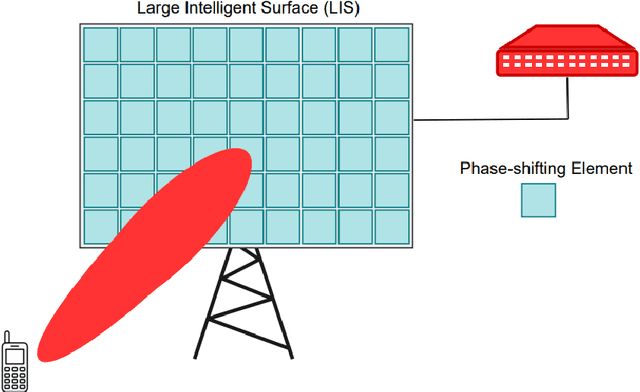
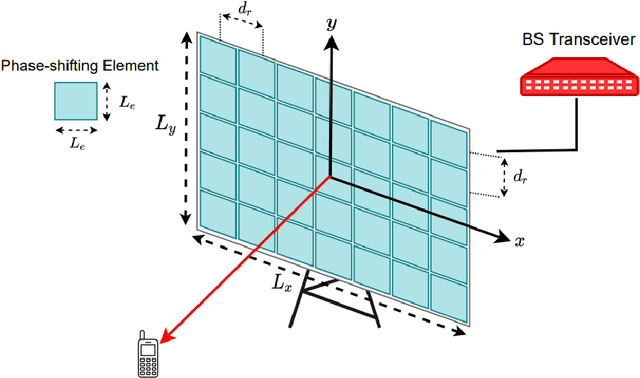
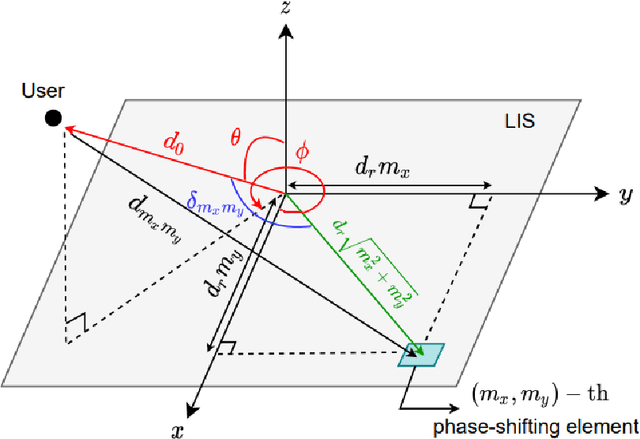
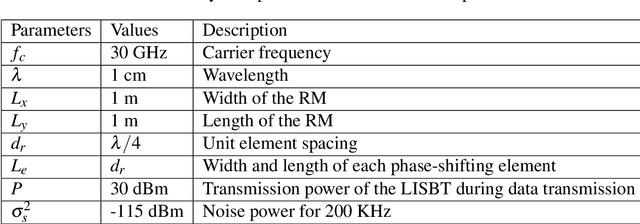
Abstract:The number of connected mobile devices and the amount of data traffic through these devices are expected to grow many-fold in future communication networks. To support the scale of this huge data traffic, more and more base stations and wireless terminals are required to be deployed in existing networks. Nevertheless, practically deploying a large number of base stations having massive antenna arrays will substantially increase the hardware cost and power consumption of the network. A promising approach for enhancing the coverage and rate of wireless communication systems is the large intelligent surface-based transceiver (LISBT), which uses a spatially continuous surface for signal transmission and receiving. A typical LIS consists of a planar array having a large number of reflecting metamaterial elements (e.g., low-cost printed dipoles), each of which could act as a phase shift. It is also considered to be a cost effective and energy efficient solution. Accurate channel state information (CSI) in LISBT-assisted wireless communication systems is critical for achieving these goals. In this paper, we propose a channel estimation scheme based on the physical parameters of the system. that requires only five pilot signals to perfectly estimate the channel parameters assuming there is no noise at the receiver. In the presence of noise, we propose an iterative estimation algorithm that decreases the channel estimation error due to noise. The proposed scheme's training overhead and computational cost do not grow with the number of antennas, unlike previous work on enormous multiple-input multiple-output (MIMO). The channel estimate scheme based on the physical properties of the Large intelligent surface-based transceiver (LISBT)-assisted wireless communication systems is the subject of our future study.
Learning to Optimize Energy Efficiency in Energy Harvesting Wireless Sensor Networks
Dec 30, 2020


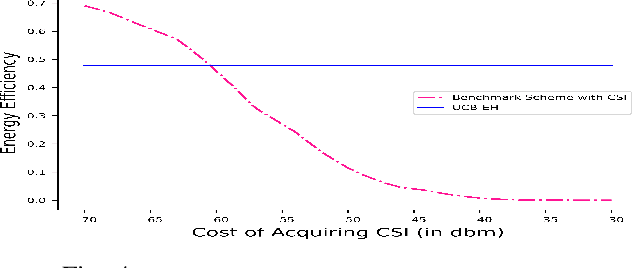
Abstract:We study wireless power transmission by an energy source to multiple energy harvesting nodes with the aim to maximize the energy efficiency. The source transmits energy to the nodes using one of the available power levels in each time slot and the nodes transmit information back to the energy source using the harvested energy. The source does not have any channel state information and it only knows whether a received codeword from a given node was successfully decoded or not. With this limited information, the source has to learn the optimal power level that maximizes the energy efficiency of the network. We model the problem as a stochastic Multi-Armed Bandits problem and develop an Upper Confidence Bound based algorithm, which learns the optimal transmit power of the energy source that maximizes the energy efficiency. Numerical results validate the performance guarantees of the proposed algorithm and show significant gains compared to the benchmark schemes.
Learning and Fairness in Energy Harvesting: A Maximin Multi-Armed Bandits Approach
Mar 16, 2020

Abstract:Recent advances in wireless radio frequency (RF) energy harvesting allows sensor nodes to increase their lifespan by remotely charging their batteries. The amount of energy harvested by the nodes varies depending on their ambient environment, and proximity to the source. The lifespan of the sensor network depends on the minimum amount of energy a node can harvest in the network. It is thus important to learn the least amount of energy harvested by nodes so that the source can transmit on a frequency band that maximizes this amount. We model this learning problem as a novel stochastic Maximin Multi-Armed Bandits (Maximin MAB) problem and propose an Upper Confidence Bound (UCB) based algorithm named Maximin UCB. Maximin MAB is a generalization of standard MAB and enjoys the same performance guarantee as that of the UCB1 algorithm. Experimental results validate the performance guarantees of our algorithm.
 Add to Chrome
Add to Chrome Add to Firefox
Add to Firefox Add to Edge
Add to Edge